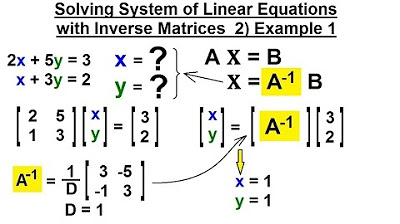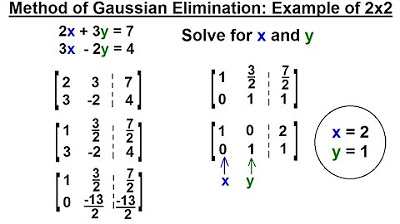PreCalculus - Matrices & Matrix Applications (27 of 33) Solving Sys of Linear Eqn with Inverse
TLDRThis video script introduces a method for solving multiple systems of linear equations with similar structures. It demonstrates how finding the inverse of a matrix, which has identical coefficients for the variables across different systems, can expedite the process of finding the values for x and y. By using the inverse multiplication with the constant matrices on the right side of the equations, the method allows for quick resolution of similar linear systems, emphasizing the efficiency and practicality of this mathematical technique.
Takeaways
- 📚 The script introduces a method for solving multiple sets of systems of linear equations efficiently.
- 🔢 The technique relies on finding the inverse of matrix A, which is common to all systems, to quickly solve for variables x and y.
- 🧠 Recognize that the constants and coefficients in each system are identical, with only the numbers on the right side of the equations differing.
- 🌟 The inverse of a matrix is calculated as 1 over the determinant times the adjugate matrix, with elements interchanged.
- 👓 The determinant is the product of the diagonal elements from the top left to the bottom right, minus the product of the diagonal elements from the top right to the bottom left.
- 📈 Once the inverse of A is found, it can be multiplied by each B matrix (the constants) to solve for x and y in each system.
- 🔍 The process is demonstrated with a step-by-step example, showing how to calculate the values for x and y in the given systems.
- 🚀 The efficiency of this method is highlighted, as it allows for quick resolution of similar systems of linear equations.
- 📝 The script provides a practical example of applying matrix inversion to solve real-world problems, such as comparing options in various scenarios.
- 💡 Understanding the concept of matrix inversion and its application to systems of linear equations is crucial for efficient problem-solving.
- 🎓 The script emphasizes the importance of careful calculation, especially when dealing with the multiplication of matrices and the final simplification of results.
Q & A
What is the main topic of the transcript?
-The main topic of the transcript is solving multiple sets of systems of linear equations using matrix inversion.
How many sets of linear equations are mentioned in the example?
-Five sets of linear equations are mentioned, with two provided in detail.
What is the key similarity between the different sets of linear equations?
-The key similarity is that the coefficients in front of the X and Y variables are the same, only the constants on the right side of the equations change.
How can we solve multiple systems of linear equations that are similar?
-We can solve them by finding the inverse of matrix A and then multiplying it with the B matrix for each system.
What is the determinant used for in this context?
-The determinant is used to find the inverse of matrix A, which is essential for solving the systems of linear equations.
What is the formula for the inverse of a 2x2 matrix?
-The inverse of a 2x2 matrix A, with elements [a, b; c, d], is given by 1/(ad-bc) * [d, -b; -c, a].
What are the values of the determinant for the given matrix in the script?
-The determinant is calculated as (4*3 - 2*5) which equals 12 - 10, thus the determinant is 2.
What is the solution for the first system of linear equations after applying the matrix inversion method?
-The solution for the first system is (-7/2, 6/2) or simplified to (-3.5, 3).
What is the solution for the second system of linear equations using the same method?
-The solution for the second system is (-6, 5).
Why is matrix inversion an efficient method for solving similar systems of linear equations?
-Matrix inversion is efficient because once the inverse of matrix A is calculated, it can be used to quickly solve each system by multiplying with the corresponding B matrix.
How does the process change when the constants on the right side of the equations change?
-When the constants change, only the B matrix changes. The inverse of matrix A remains the same and is multiplied by the new B matrix to find the new solution.
Outlines
📚 Introduction to Solving Systems of Linear Equations
This paragraph introduces the viewer to a technique for solving multiple sets of systems of linear equations. It presents an example with two systems, each consisting of two equations, and highlights the similarities between them, such as the same coefficients for the x and y variables but different constants on the right side of the equations. The speaker explains that by finding the inverse of matrix A, one can quickly solve all similar systems of linear equations by multiplying the inverse with the B matrix (although mistakenly referred to as a vector at first). The process involves interchanging elements in the matrix to calculate the determinant and then using this to find the inverse, which is used to solve for the variables x and y in each system.
🧠 Calculation of the Inverse Matrix and Solving the First System
In this paragraph, the speaker delves into the specifics of calculating the inverse of matrix A. The process involves interchanging the elements in the matrix and calculating the determinant, which turns out to be 2. Using the determinant, the inverse of the matrix is found to be 1/2 times the matrix with elements adjusted accordingly. The speaker then applies this inverse matrix to the B1 matrix (representing the first system of equations) to find the values for x and y. Through a series of multiplications and additions, the solution for the first system is determined to be x = -7 and y = 6.
🔄 Solving the Second System Using the Inverse Matrix
The speaker continues the explanation by applying the previously calculated inverse matrix to the B2 matrix (representing the second system of equations). By carefully multiplying the inverse matrix with the elements of B2, the speaker arrives at a different solution for x and y. However, there is a mistake in the calculation as the speaker seems to have switched elements between B1 and B2. Despite this, the intended process is clear: using the inverse matrix to quickly solve for the variables in each system by multiplying it with the corresponding B matrix.
Mindmap
Keywords
💡Linear Equations
💡Systems of Linear Equations
💡Inverse of a Matrix
💡Matrix
💡Determinant
💡Coefficients
💡Constants
💡Vector
💡Solving Techniques
💡Efficiency
💡Similar Systems
Highlights
Introduction to solving multiple sets of linear equations using matrix inversion.
Demonstration of a technique applicable to systems with similar coefficient matrices but different constants.
Explanation of how to find the inverse of a matrix to solve for x and y in each system.
Illustration of the process by showing the first system of linear equations: 4X + 5y = 2 and 2X + 3y = 4.
Presentation of the second system of linear equations: 4X + 5y = 1 and 2X + 3y = 3.
Discussion on the similarities across different sets of linear equations, noting the constants and coefficients remain the same.
Clarification that the term 'B vector' was mistakenly used instead of 'B matrix'.
Step-by-step calculation of the inverse of matrix A, including the interchange of elements and determinant calculation.
Solution of the first system of linear equations by multiplying the inverse of A with the B1 matrix.
Solution of the second system by multiplying the inverse of A with the B2 matrix, showing the specific calculations.
Result of the first system's solution: X = -7 and Y = 6.
Result of the second system's solution: X = -6 and Y = 5.
Emphasis on the efficiency of using matrix inversion to solve similar systems of linear equations.
Explanation of how the inverse of a matrix allows for quick resolution of various systems with changing constants.
The practical application of this method in comparing different options in a given situation.
The only difference between the systems is the numbers on the right side of the equal sign.
The process of solving linear equations is demonstrated with a practical example, showing the method's applicability.
The transcript includes a casual and relatable moment when the speaker's eagle falls down and they need to put it back up.
Transcripts
Browse More Related Video

Matrices to solve a system of equations | Matrices | Precalculus | Khan Academy

PreCalculus - Matrices & Matrix Applications (26 of 33) Solving Sys of Linear Eqn with Inverse

Matrix equations and systems | Matrices | Precalculus | Khan Academy

PreCalculus - Matrices & Matrix Applications (6 of 33) Method of Gaussian Elimination: 2x2 Matrix

PreCalculus - Matrices & Matrix Applications (1 of 33) What is a Matrix? 1

PreCalculus - Matrices & Matrix Applications (28 of 33) Solving Sys of Linear Eqn with Inverse
5.0 / 5 (0 votes)
Thanks for rating: